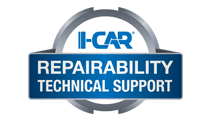
OEM Restraints System Part Replacement Search
2007 Saturn Aura
DISABLE PROCEDURE AND TIME (Always Check Service Manual)
1. Turn the steering wheel so that the vehicle's wheels are pointing straight ahead.2. Place the ignition in the OFF position.
3. Disconnect the negative battery cable from the battery.
4. Wait 1 minute before working on system.
REV: 10/2010
PARTS THAT MUST BE REPLACED FOLLOWING A DEPLOYMENT
After a collision involving air bag deployment, replace the following components:• Inflatable restraint I/P module, if deployed [AIRBAG,INSTRUMENT PNL]
• Inflatable restraint steering wheel module [AIRBAG,STEERING WHEEL]
• Inflatable restraint SDM [MODULE,AIRBAG CONTROL]
• Inflatable restraint front end sensor, left/right [AIRBAG SENSOR,FRONT, LT/RT]
• Inflatable restraint seat belt pretensioners
• Replace any seat belt system that was in use during the collision serious enough to deploy any automatic restraint device such as air bags and seat belt pretensioners
• Any restraint system part or wiring identified by the restraint diagnostic checks
After a collision involving side air bag deployment, replace the following components:
• Inflatable restraint side impact sensors (SIS), left/right, on the side of the impact [AIRBAG SENSOR,FRT DOOR]
• Inflatable restraint roof rail module, left/right, on the side of the impact [AIRBAG,ROOF]
• Driver or Passenger Seat Side Inflatable Restraint Module, if deployed [AIRBAG,FRONT SEAT]
• Inflatable restraint SDM [MODULE,AIRBAG CONTROL]
• Inflatable restraint seat belt pretensioner
• Replace any seat belt system that was in use during the collision serious enough to deploy any automatic restraint device such as air bags and seat belt pretensioners
• Any restraint system part or wiring identified by the restraint diagnostic checks
• Replace any seat belt system that was in use during the collision serious enough to deploy any automatic restraint device such as air bags and seat belt pretensioners. This not only includes seat belt systems in use by people of adult size, but seat belt systems used to secure child restraints, infant carriers and booster seats, including LATCH system and top tether anchorages.
• Replace any seat belt system that has torn, worn, or damaged components. This not only includes adult seat belt systems, but built-in child restraints and LATCH system components, if any.
• Replace any seat belt system if you observe the words "REPLACE" or "CAUTION", or if a yellow tag is visible. Do not replace a seat belt if only the child seat caution label is visible.
• Replace any seat belt system if you are doubtful about its condition. This not only includes adult seat belt systems, but built-in child restraints, LATCH system components, and any restraint system used to secure infant carriers, child restraints, and booster seats.
• Do NOT replace single seat belt system components in vehicles that have been in a collision as described above. Always replace the entire seat belt system with the buckle, guide and retractor assembly, which includes the latch and webbing material.
• After a minor collision where no automatic restraint device was deployed, seat belt system replacement may not be necessary, unless some of the parts are torn, worn, or damaged.
PARTS THAT MUST BE INSPECTED AND REPLACED IF DAMAGED
Inspections Required After a Collision:After a collision, inspect the following components as indicated. If any damage is detected, replace the component. If damage to the mounting points or mounting hardware is detected, repair the component or replace the hardware as needed.
• Steering column--Perform the steering column accident damage checking procedures. Refer to Steering Column Accident Damage Inspection Steering Column Accident Damage Inspection .
• Instrument panel (I/P) knee bolsters and mounting points--Inspect the knee bolsters for bending, twisting, buckling, or any other type of damage.
• I/P brackets, braces, etc.--Inspect for bending, twisting, buckling, or any other type of damage.
• Seat belts--Perform the seat belt operational and functional checks. Refer to Operational and Functional Checks .
• Seats and seat mounting points--Inspect for bending, twisting, buckling, or any other type of damage.
• Passenger seat bottom with passenger presence system (PPS) --Check for any DTCS or problems that may cause the PPS not to function properly.
• The roof and headliner mounting points.
• Any restraint system part or wiring identified by the restraint diagnostic checks
After a collision involving air bag deployment, Perform additional inspections on the following components:
• Steering wheel module coil and the coil wiring pigtail--Inspect for melting, scorching, or other damage due to excessive heat.
• Mounting points or mounting hardware for the I/P, steering wheel module, SDM, and pretensioners--Inspect for any damage and repair or replace each component as needed
• Any restraint system part or wiring identified by the restraint diagnostic checks
After a collision involving side air bag deployment, Perform additional inspections on the following components:
• Mounting points or mounting hardware for the SIS--Inspect for any damage and repair or replace each component as needed.
• Mounting points or mounting hardware for the roof rail module (left/right) on the side of impact--Inspect for any damage and repair or replace each component as needed.
• Mounting points or mounting hardware for the SDM and seat belt pretensioners--Inspect for any damage and repair or replace each component as needed.
• Any restraint system part or wiring identified by the restraint diagnostic checks
Following the deployment of a side impact air bag, inspect the following parts for damage. Replace these parts if necessary:
• The seat cushion frame
• The seat recliner, if equipped
• The seat adjuster
• The seat back frame
• Any restraint system part or wiring identified by the restraint diagnostic checks
• Important: The front passenger seat is equipped with a PPS, which detects an occupant. If the requirements for disabling the I/P air bag are met then the PPS will communicate with the sensing and diagnostic module (SDM) to disable/turn OFF the I/P air bag, even in a accident. For more information on the PPS refer to SIR System Description and Operation .
